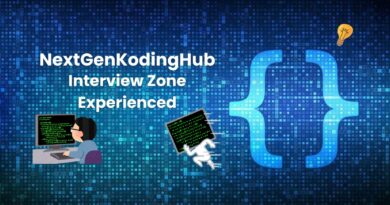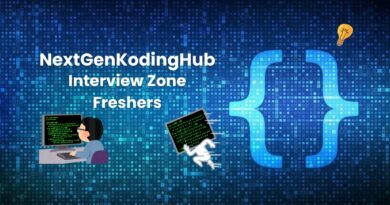DevOps and Cloud Interview
DevOps & Cloud Interview Preparation
DevOps & Cloud Interview – 30+ Expert-Level Questions and Detailed Answers
Preparing for a DevOps & Cloud Interview requires thorough understanding of automation, cloud infrastructure, continuous integration/deployment, and containerization technologies. This comprehensive guide provides over 30 frequently asked questions designed to sharpen your skills and help you excel in your DevOps & Cloud Interview. From fundamental concepts to advanced practices, these questions cover essential areas employers focus on in today’s competitive landscape.
With this DevOps & Cloud Interview preparation, you will gain clarity on infrastructure as code, cloud providers, CI/CD pipelines, and monitoring — critical topics for roles in DevOps and cloud engineering.
1. What is DevOps and why is it important?
DevOps is a cultural and technical movement combining software development (Dev) and IT operations (Ops) to shorten development cycles, increase deployment frequency, and improve reliability through automation and collaboration.
2. Explain continuous integration (CI) and continuous deployment (CD).
CI is the practice of merging code changes frequently into a shared repository with automated builds and tests. CD automates deploying code to production or staging environments after successful CI, enabling rapid delivery.
3. What are containers and how do they differ from virtual machines?
Containers package software with dependencies and run isolated at the OS level using the host kernel. VMs virtualize hardware and run separate OS instances. Containers are lightweight, start faster, and consume fewer resources.
4. Describe Infrastructure as Code (IaC).
IaC automates infrastructure provisioning using code-based configuration files (e.g., Terraform, CloudFormation), enabling version control, repeatability, and consistency.
5. What is Kubernetes and why is it popular?
Kubernetes is an open-source container orchestration platform that automates deployment, scaling, and management of containerized applications, supporting high availability and fault tolerance.
6. How do you monitor applications and infrastructure in a cloud environment?
Use tools like Prometheus, Grafana, CloudWatch, ELK stack for metrics collection, alerting, log analysis, and visualization to maintain system health and troubleshoot issues.
7. What are some common cloud service models?
Infrastructure as a Service (IaaS), Platform as a Service (PaaS), and Software as a Service (SaaS) represent different levels of abstraction for provisioning resources in the cloud.
8. Explain the difference between public, private, and hybrid clouds.
Public clouds are owned by third-party providers and offer shared resources, private clouds are dedicated environments for one organization, and hybrid clouds combine both for flexibility.
9. What is a CI/CD pipeline and what are its key components?
A CI/CD pipeline automates building, testing, and deploying code changes. Key components include source code repository, build server, testing framework, artifact repository, and deployment automation.
10. How do you handle secrets management in DevOps?
Use tools like HashiCorp Vault, AWS Secrets Manager, or Kubernetes secrets to securely store and manage credentials and sensitive information, ensuring access control and auditability.
11. What is the role of configuration management tools?
Tools like Ansible, Puppet, and Chef automate software installation, configuration, and management across multiple servers to ensure consistency and reduce manual errors.
12. Explain rolling updates and blue-green deployments.
Rolling updates gradually replace old versions with new ones without downtime, while blue-green deployments maintain two identical environments to switch traffic instantly for zero downtime releases.
13. How does load balancing work and why is it important?
Load balancers distribute incoming network traffic across multiple servers to ensure high availability, reliability, and improved performance.
14. What is the difference between horizontal and vertical scaling?
Horizontal scaling adds more machines or nodes, while vertical scaling increases resources (CPU, RAM) of an existing machine.
15. How do you ensure security in cloud environments?
Implement identity and access management, encryption, network segmentation, regular audits, vulnerability scanning, and compliance with security best practices.
16. What is a service mesh?
A service mesh manages communication between microservices, providing features like load balancing, authentication, monitoring, and traffic control, with tools such as Istio or Linkerd.
17. How do you automate infrastructure provisioning?
Use Infrastructure as Code tools like Terraform or AWS CloudFormation with version-controlled scripts to define, deploy, and manage infrastructure automatically.
18. Describe the differences between GitOps and traditional DevOps.
GitOps uses Git repositories as a single source of truth for both infrastructure and application code, enabling automated deployment and easier rollback, whereas traditional DevOps may separate code and infrastructure management.
19. What is a container registry?
A container registry stores and distributes container images. Examples include Docker Hub, Amazon ECR, and Google Container Registry.
20. Explain the concept of immutable infrastructure.
Immutable infrastructure means servers or components are never modified after deployment; instead, new versions are provisioned to replace the old ones, increasing reliability and reducing configuration drift.
21. How does caching improve system performance?
Caching stores frequently accessed data closer to the user or application, reducing latency and load on backend systems.
22. What are microservices?
Microservices architecture breaks applications into loosely coupled, independently deployable services, improving scalability, maintainability, and fault isolation.
23. What is a webhook?
A webhook is a method to send real-time data from one application to another via HTTP callbacks triggered by events.
24. How do you monitor container health?
Use liveness and readiness probes, logging, metrics collection, and alerting integrated with orchestration platforms like Kubernetes.
25. Explain the CAP theorem.
The CAP theorem states that a distributed system can provide only two of three guarantees simultaneously: Consistency, Availability, and Partition tolerance.
26. How do you manage version control in DevOps?
Use Git or other version control systems to track code changes, collaborate via branching and pull requests, and integrate with CI/CD pipelines.
27. What is the difference between stateful and stateless applications?
Stateful applications retain session information between requests; stateless applications treat each request independently without storing session state.
28. What is autoscaling?
Autoscaling automatically adjusts compute resources based on demand to optimize cost and performance.
29. How do you secure APIs in cloud environments?
Use authentication (OAuth, JWT), authorization, rate limiting, encryption (TLS), and API gateways to secure access.
30. What are blue-green and canary deployments? Compare them.
Blue-green deployment switches traffic between two identical environments instantly, minimizing downtime. Canary deployment gradually rolls out changes to a small subset of users before full deployment, reducing risk.
31. What logging best practices do you follow in DevOps?
Centralize logs, use structured logging, ensure log retention policies, mask sensitive data, and integrate with monitoring tools for alerts.
32. Explain the role of monitoring and alerting in DevOps.
Monitoring tracks system health and performance, while alerting notifies teams about issues to enable fast incident response and resolution.
Conclusion
A strong grasp of these DevOps & Cloud Interview questions will prepare you to confidently discuss automation, cloud architecture, and deployment strategies. Practice these topics and incorporate real-world examples to stand out in your interviews.



